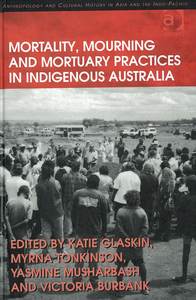A place to rest: dying, residence, and community stability in remote Arnhem Land
Barber, Marcus (2008) A place to rest: dying, residence, and community stability in remote Arnhem Land. In: Glaskin, Katie, Tonkinson, Myrna, Musharbash, Yasmine, and Burbank, Victoria, (eds.) Mortality, Mourning and Mortuary Practices in Indigenous Australia. Anthropology and Cultural History in Asia and the Indo-Pacific . Ashgate, Farnham, UK, pp. 153-169.
![[img]](https://researchonline.jcu.edu.au/7433/2.hassmallThumbnailVersion/7433_Barber_2008_cover.jpg)
|
Image (JPEG) (Book Cover)
- Cover Image
Download (222kB) |
|
|
PDF (Published Version)
- Published Version
Restricted to Repository staff only |
Abstract
[Extract] The old men who provide the ethnographic core of this chapter are all are closely connected to Yilpara and GanGan, two of the largest remote homelands' in Blue Mud Bay in north-east Arnhem Land. Each homeland population is dominated by a patrilineal group or clan,' who own the country on which it is sited. Yilpara has a stable population of approximately 100, GanGan a population of approximately 70. The men I discuss are related to each other as fathers, brothers and sons. My primary focus is Yilpara, which in some ways is typical of many remote indigenous communities; its residents are poor, lack formal schooling, are accommodated in overcrowded housing with limited infrastructure, and are predominantly welfare dependent, with art sales and minor royalty payments providing the only nongovernment income. Such facts would accord with many people's expectations of remote Aboriginal settlements. Yet another fact would not, particularly given recent media attention on violence and drug misuse in such remote places. In 18 months of fieldwork and numerous subsequent visits to Yilpara, I have not witnessed a single act of violence, and have heard reports of only a small number. Yilpara is alcohol-free, partly because of its remoteness but predominantly because its residents insist such a ban is important. Petrol sniffing is also non-existent, despite its presence at larger nearby settlements such as Gapuwiyak and Groote Eylandt. I highlight these more unusual characteristics precisely because of their relevance to what follows. My argument is that the slow, measured deaths described here are not just a consequence of this relatively peaceful situation; they are partly responsible for generating it.
| Item ID: | 7433 |
|---|---|
| Item Type: | Book Chapter (Research - B1) |
| ISBN: | 978-0-7546-7449-8 |
| Keywords: | Indigenous; anthropology; death; place; demography; heritage |
| Related URLs: | |
| Date Deposited: | 15 Jan 2010 00:54 |
| FoR Codes: | 16 STUDIES IN HUMAN SOCIETY > 1601 Anthropology > 160104 Social and Cultural Anthropology @ 80% 20 LANGUAGE, COMMUNICATION AND CULTURE > 2002 Cultural Studies > 200201 Aboriginal and Torres Strait Islander Cultural Studies @ 20% |
| SEO Codes: | 95 CULTURAL UNDERSTANDING > 9503 Heritage > 950302 Conserving Aboriginal and Torres Strait Islander Heritage @ 40% 97 EXPANDING KNOWLEDGE > 970116 Expanding Knowledge through Studies of Human Society @ 30% 94 LAW, POLITICS AND COMMUNITY SERVICES > 9401 Community Service (excl. Work) > 940102 Aboriginal and Torres Strait Islander Development and Welfare @ 30% |
| Downloads: |
Total: 840 Last 12 Months: 4 |
| More Statistics |



